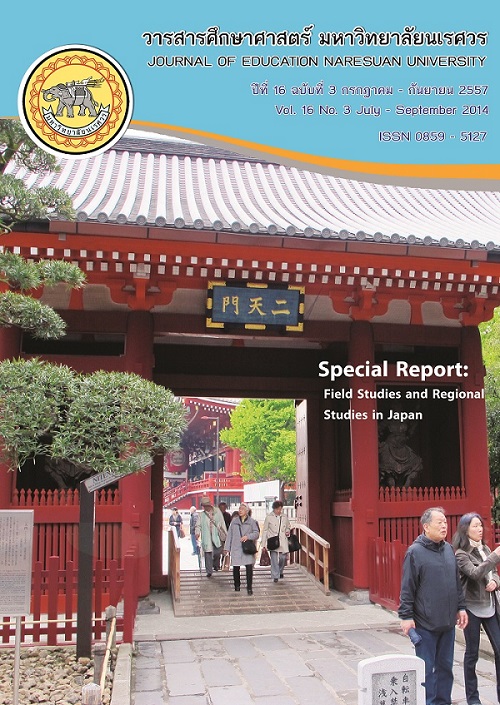การพัฒนารูปแบบการเรียนการสอน เรื่อง ปริมาณสารสัมพันธ์แบบเน้นการ บูรณาการ การฝึกอบรมกระบวนการสืบเสาะหาความรู้ และการเรียนรู้แบบร่วมมือ เพื่อส่งเสริมการคิดอย่างมีวิจารณญาณ สำหรับนักเรียนระดับมัธยมศึกษา ตอนปลาย ห้องเรียนพิเศษวิทยาศาสตร์
Main Article Content
Abstract
บทคัดย่อ
การวิจัยในครั้งนี้มีวัตถุประสงค์ เพื่อพัฒนารูปแบบการเรียนการสอน เรื่อง ปริมาณสัมพันธ์ แบบเน้นการบูรณาการ การฝึกอบรมกระบวนการสืบเสาะหาความรู้ และการเรียนรู้แบบร่วมมือ เพื่อส่งเสริมการคิดอย่างมีวิจารณญาณ สำหรับนักเรียนระดับมัธยมศึกษาตอนปลาย ห้องเรียนพิเศษวิทยาศาสตร์ ดำเนินการโดยใช้กระบวนการวิจัยและพัฒนาเป็น 2 ขั้น คือ 1) ขั้นสร้างและหาคุณภาพของรูปแบบ และ 2) ขั้นศึกษาผลการใช้รูปแบบที่พัฒนา กลุ่มตัวอย่างเป็นนักเรียนชั้นมัธยมศึกษาปีที่ 5 ห้องเรียนพิเศษวิทยาศาสตร์ โรงเรียนวิทยานุกูลนารีภาคเรียนที่ 1 ปีการศึกษา 2556 จำนวน 29 คน เครื่องมือวิจัย คือ แบบวัดการคิดอย่างมีวิจารณญาณ แบบวัดผลสัมฤทธิ์ทางการเรียน เรื่อง ปริมาณสัมพันธ์ และแบบบันทึกการเรียนรู้ วิเคราะห์ข้อมูล โดยการหาค่าเฉลี่ยความเบี่ยงเบนมาตรฐาน การทดสอบทีแบบกลุ่มเดียว แบบไม่อิสระ พบว่า รูปแบบการเรียนการสอนที่พัฒนาประกอบด้วยกระบวนการเรียนรู้ที่ผู้เรียนเป็นผู้ใช้กระบวนการเรียนรู้ 4 ขั้น คือ ขั้นตั้งคำถาม (Question : Q) ขั้นหาคำตอบ (Answer : A) ขั้นแลกเปลี่ยนเรียนรู้ (Share : S) และขั้นประเมินตามสภาพจริง (Assessment : A)หรือ QASA Model นอกจากนี้พบว่า 1) รูปแบบนี้ มีความเหมาะสมอยู่ในระดับมาก ( = 4.47, S.D.=0.75) มีความเป็นไปได้ในทำงปฏิบัติ 2) นักเรียนมีการคิดอย่างมีวิจารณญาณ และผลสัมฤทธิ์ทางการเรียนหลังเรียนด้วยรูปแบบที่พัฒนาขึ้นสูงกว่าก่อนเรียน อย่างมีนัยสำคัญทางสถิติที่ระดับ .01 นักเรียนส่วนใหญ่คิดว่า รูปแบบนี้เป็นความแปลกใหม่ ได้ฝึกคิดวิเคราะห์ที่ช่วยให้ตื่นตัวในการเรียนตลอดเวลา การจัดกลุ่มเรียนรู้ทำให้มีปฏิสัมพันธ์ที่ดีกับเพื่อนและครู มีความสุขจากการเรียนรู้อย่างอิสระตามศักยภาพ ทำให้รู้สึกดีต่อวิชาเคมี
คำสำคัญ : รูปแบบการเรียนการสอนเรื่อง ปริมาณสารสัมพันธ์/ การฝึกอบรมกระบวนการสืบเสาะหาความรู้/การเรียนรู้แบบร่วมมือ/ การคิดอย่างมีวิจารณญาณ/ ห้องเรียนพิเศษวิทยาศาสตร์
Abstract
The purpose of this research was to develop the instructional model on Stoichiometry basedon integrated inquiry training and cooperative learning to enhance critical thinking for upper secondarystudents in an enrichment science classroom. This model was called QASA Model that had foursteps of teaching consisting Question : Q, Answer : A, Share : S and Assessment: A. Theprocedure of research and development comprised 2 steps, 1) construct and verify the quality of themodel, and 2) study effect of implementation. This samples were 29 students of EnrichmentClassroom on Matthayomsuksa 5 in Witthayanukulnaree School. The research instruments werecritical thinking test, achievement test, and learning journal. The analytical statics were mean,standard deviation and one group t-test dependent. The results were as follows, 1) this instructionalmodel was at high quality level ( = 4.47, S.D. =0.75) and appropriate for students in the enrichmentscience classroom, 2) the students had score of both critical thinking and achievement at postlearning stage more than pre learning stage at statistical significant of .01. The new model broughtabout analytical thinking practice and active learning. Group Learning management gave studentsgood relationship among friends and the teacher. They gained happiness and freedom to learn, andfelt positive in learning chemistry.
Keywords: Instructional model/ Inquiry training/ Cooperative learning/ Critical thinking/ Enrichmentscience classroom
Article Details
The owner of the article does not copy or violate any of its copyright. If any copyright infringement occurs or prosecution, in any case, the Editorial Board is not involved in all the rights to the owner of the article to be performed.


